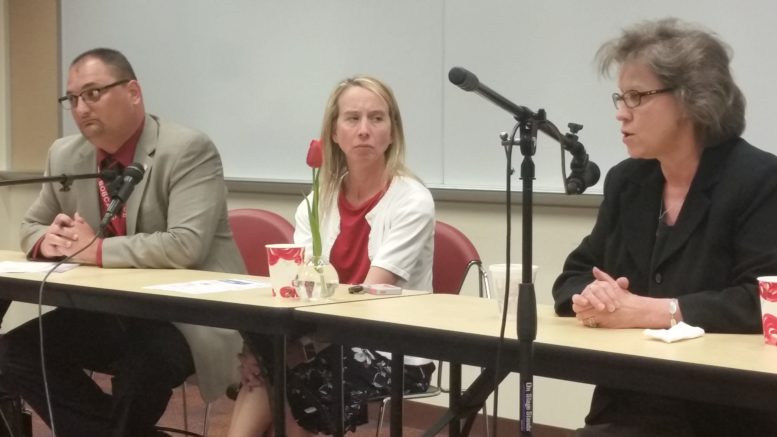By JAN LARSON McLAUGHLIN
BG Independent News
Children with learning disabilities used to be removed from regular classrooms, away from regular curriculum, away from regular kids.
When Lorraine Flick started teaching 30 years ago, children with special needs were tucked away from her classroom. “They went away to some other teacher. I never saw them.”
That is no longer the case. Those children are taught in the “least restrictive environment.” So many of those students with special needs are now in regular classrooms.
“Over the years, we have found that students who are segregated or separated from their peers,” can learn in regular classrooms if given a little extra support, said Flick, a former elementary principal who is now director of children’s services at Wood Lane.
How Bowling Green schools meet the needs of these children was discussed Monday evening during a panel discussion on special education for the League of Women Voters.
Schools are legally bound to offer education in the “least restrictive environment,” said Bob Yenrick, executive director of pupil services for Bowling Green City Schools. If a child can “access the curriculum” with the extra help of being paired with a “para-professional” in the classroom, then that child does not need to be put in a different class.
“We need to make sure we are honoring that least restrictive environment at all times,” Yenrick said.
That change has consequences for schools, and challenges for teachers as well as for the children. But those challenges are worth confronting, according to the panel.
Schools still have special education teachers, but now they are referred to with the politically correct name of “intervention specialists,” according to Christie Walendzak, special education coordinator with Bowling Green City Schools.
The specialists look at every student to make sure they are keeping up with curriculum, and identify the areas a child may need extra help. They try to intervene early so children never qualify for special education services.
Those who qualify for special education services are give Individualized Education Plans, addressing their specific needs, Walendzak said. Approximately 535 students in the Bowling Green school system have IEPs. Some families choose to send those students to private schools, which Bowling Green schools then have to fund.
Bowling Green tries to reach children early who might need extra help. That means getting to kids before they start kindergarten.
“We start when children are 2 ½,” Yenrick said. “We want to develop strategies to develop positive outcomes for them.”

League of Women Voters learn how BG school district handles special needs
Suspected problems are reported by pediatricians who notice young children aren’t hitting milestones, or by day cares, parents, grandparents, or anyone with concerns. Reporting has become more common since autism diagnoses have “exploded,” Flick said.
Programs such as Help Me Grow evaluate the children, and go to families’ homes to work with the parents.
“Who better than mom and dad to serve that child every day,” Flick said. “The children make significantly more progress.”
If identified early enough, the school’s services can start two years prior to the child entering kindergarten.
“When they hit age 3, our services kick in that day if the parents want them,” Yenrick said.
With such services as occupational, speech or physical therapy, the hope is that children will be up to speed by time they get to kindergarten.
“The sooner we find out, the sooner we can help, the sooner we can make a difference in that child’s life,” Yenrick said. “We see tremendous growth in these kids.”
The majority of the children reached by the early intervention never end up needing IEPs, Flick said.
Some students are matched up with para-professionals, who are hired as support people for specific students. Some students still need to leave their regular classrooms for more intense intervention, such as greater preparation for a new lesson or more reinforcement after the lesson is taught, Walendzak explained. In some cases, these children have extended school years into the summer if they regress greatly during breaks from school.
Yenrick expressed his disdain for standardized testing, and explained that students in special education classes are required to take the same tests as other students. That not only puts an awful lot of pressure on those students, but it also draws down the overall scores of the district.
Yenrick criticized the upheaval caused by frequent testing requirement changes, and questioned the value of the tests accurately reflecting what a child has learned. He suggested that Ohio require its politicians to take the 9th grade test and face the pressure of having their scores published just as students do. Only then, will the testing requirements be made more reasonable, he said.
“We all in this room want kids to have what they need to be successful,” Yenrick said.
And Bowling Green does a better job at providing that than most, he added.
“I had culture shock coming to Bowling Green – in a good way,” Yenrick said. “This is a Utopia in my eyes.”

